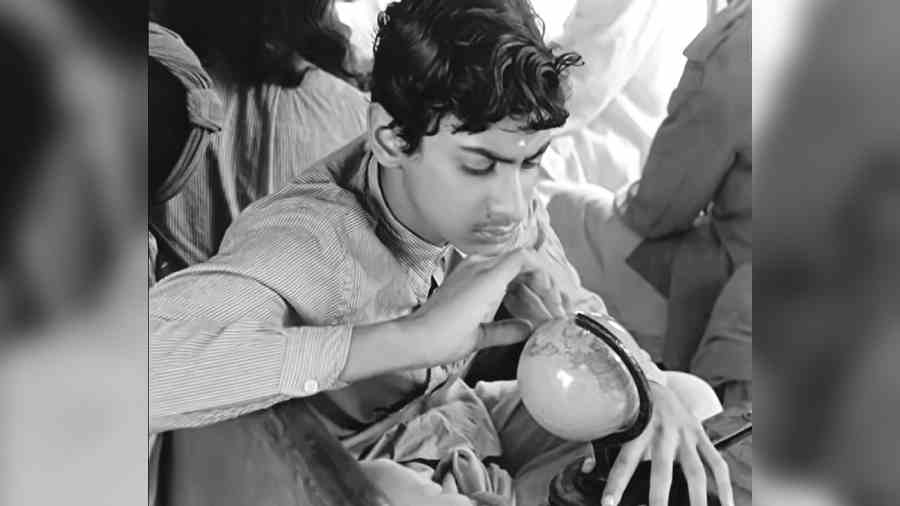There is a scene in Satyajit Ray’s film, Aparajito, where Apu, a boy in his late teens, leaves his widowed mother in her village to go to college in Calcutta. As he walks out of their dilapidated mud hut, Apu carries in one hand his bedding roll and in the other, a large steel trunk with all his belongings and a globe. A gift from the headmaster of his local school, the globe is precious to Apu. He spent the previous evening in breathless excitement, showing it to his mother; she had no idea what it was. On it, he showed her Calcutta, a city neither of them had seen in real life. As he leaves for the city the next morning, it is clear from his body language that the globe is now his most prized possession. His mother might think he needs clothes and daily necessities as he goes to live in the boarding school, but he thinks it is not less important to take the globe with him wherever he goes. He spends many hours gazing at it with great affection and curiosity and, finally, steps out into the world holding close to his body this intimate model of the planet.
Ray here is not depicting a real scene from Bibhutibhushan Bandyopadhyay’s classic novel, Aparajito, on which the film is based — indeed, there is no globe in the novel. But through this invented scene, Ray captures the essential spirit of the book. Aparajito throbs with desire for a larger world beyond what can be apprehended with the senses. But it also evokes, dreamily and sensually, the slow transition of the romantic and imaginative village boy, Apu, from the novel, Pather Panchali, into the intellectually curious young man who sets out to make his way in a wider, bewildering world in Aparajito. The scene with the globe captures the spatial imagination of this remarkable coming-of-age story. In crafting a scene like this and the spirit behind it, Ray and Bandyopadhyay, respectively, summon an apparent contradiction: the provincial origins of cosmopolitanism.
What do you do when you are poor, come from a remote village, but wish to explore the whole world, if not with your body, at least with your soul? The discrepant desire is the force behind the making of the provincial polymath — chaotic, undisciplined, passionate, forever an amateur. In college in Calcutta, Apu moves back and forth whimsically among history, drama, astronomy, poetry, botany, and every discipline he stumbles on. His friend, Pranab, a far more organised scholar, reprimands him: “Dur? O ki pora? Tomar to pora noy, pora pora khela.” (“Come on, you call that studying? That is not studying, it is making a sport of it.”) Just around that time, another young man, also arrived in the city from the provinces and also enrolled in a city college, was dallying in intense but eclectic autodidacticism. Had Apu been alive outside a novel, they might have run into each other, perhaps in the bookstores fringing the pavements of College Street or in the Bowbazar sweetshops.
The young man alive in history, Nirad C. Chaudhuri, has most always represented to me the ideal spirit of the globe-hugging Apu on a trek from the province to the colonial metropolis. Chaudhuri arrived in Calcutta from the country-town of Kishoreganj, now in Bangladesh, and Apu came from Nishchindipur, a village to the south of Calcutta. Both attended Ripon College (as did Apu’s creator, Bibhutibhushan), at some distance from Presidency College in College Street — a college that intimidated the poor and rustic Apu. And both were students in a peripheral and precarious way. There were moments of interaction with memorable teachers and, occasionally, a riveting lecture grabbed their attention, but they spent most of their time reading on their own, earnestly but patchily, occasionally trying to impose structure but failing more often than not, setting themselves afloat in a scholarly flânerie that defied the curricular grids of college education.
The proverbial image of this defiance is that of a student lounging in the back of the lecture hall, reading a book for pleasure while the tedious and uninspiring lecturer drones on. That exact image is captured in the novel, Aparajito, as well as in Chaudhuri’s The Autobiography of an Unknown Indian. Apu is caught in the back of the lecture hall with a book that is not welcome in a class on logic — Francis Turner Palgrave’s Golden Treasury. The professor is not amused. After a moment of public humiliation, Apu slips out through the back door to head to the library, where he chats with the staff and borrows a volume of Edward Gibbon’s history of Rome. And in his autobiography, Chaudhuri records a similar indifference to the lectures at Calcutta University, making exceptions for just a handful of professors. “As for the rest,” he writes, “I paid no attention whatever to what they said and sat on one of the back-benches, either reading a book of my choice, or scribbling, or thinking my own thoughts.” If there is an institution to which the autodidact has a debt, it is the library. “It was another institution, the Imperial Library, to which I owe nearly all my higher education.”
By fleeing the classroom, Apu and Chaudhuri attempted to escape the bureaucratised tedium of colonial higher education even as they sought a freewheeling imaginative life in the European humanities. While the fierce debate over Indian response to British education remains eternally irresolvable — whether it formed the mask of imperial conquest, was just a clerk-making enterprise, was actively desired by colonial Indians or was a clumsy encounter of radically disparate subjectivities — one thing remains clear. The tedium inspired by the heavily bureaucratised curricular and pedagogic structure, combined with the unrelentingly mechanical preparation of predictable examinations, has invited generations of students to wander off the back benches, physically or imaginatively, to become amateurs and autodidacts of great charm. Nirad C. Chaudhuri, who would have turned one hundred and twenty-five this year, might be the most seductively prickly of them, but the great colonial university in the city of Calcutta, the coveted point of Apu’s globe, has paradoxically produced some of the most memorable shirkers of both syllabus and classroom.
Saikat Majumdar is Professor of English & Creative Writing at Ashoka University











